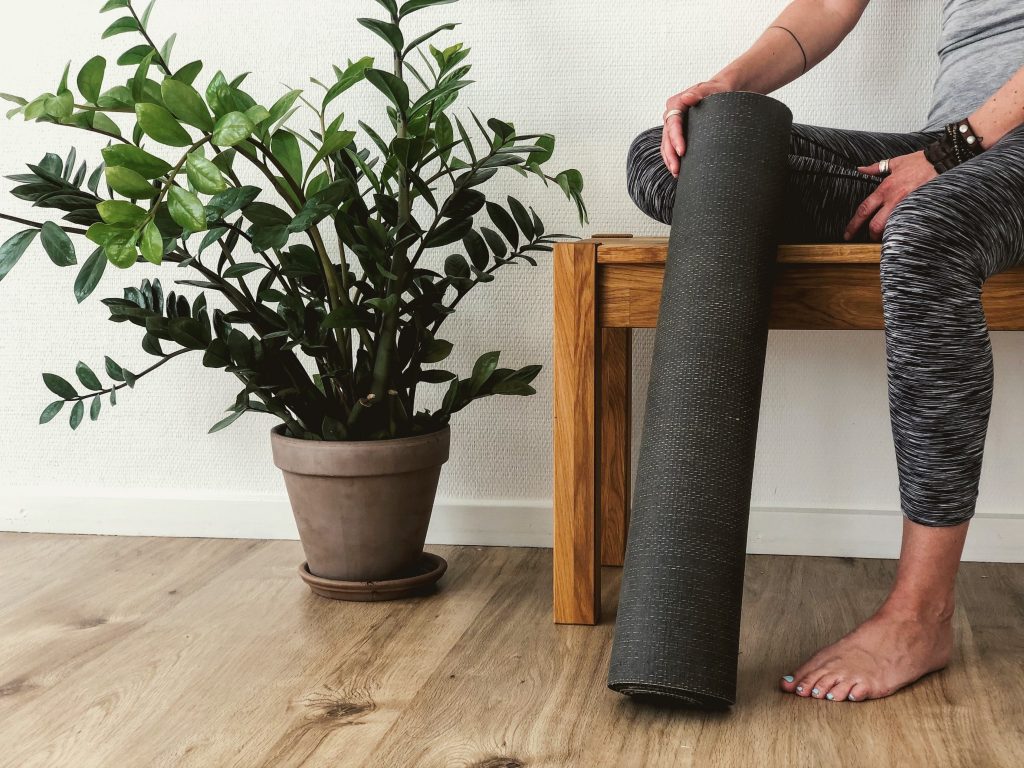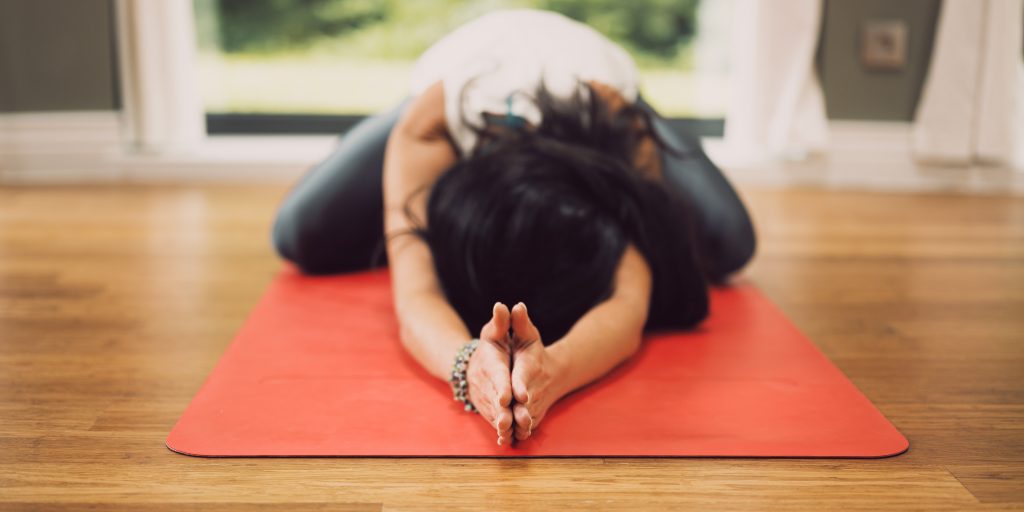Below you will find a long list of different mental health tips and techniques. Read through them and pick and choose the ones you feel work well for you.
*If you need help, or you are in an emergency or crisis, visit “Support Resources“.*
The miracle is not to walk on water. The miracle is to walk on the green earth, dwelling deeply in the present moment and feeling truly alive.
Thich Nhat Hanh
Mindfulness Techniques

What Is Mindfulness?
When you are mindful, you are aware of what is going on “here-and-now”. So, the opposite of mindfulness would be driving from work to home, pulling into the driveway, and realizing you don’t remember how you got there – you were lost in your thoughts.
With mindfulness, we very much live in the “present moment”, so we are able to notice and even label what’s going on all around us or what is going on inside our bodies and minds. A big benefit of practicing mindfulness is a calmer mind and improved mental wellbeing overall.
16 Mindfulness Techniques
**adapted from Sarah Beach
- Breathe – pay attention to your breath
- Change it up – change up your routine or do something you would not normally do
- Watch your words – speak kindly and empathetically; your words are powerful and hold a lot of energy
- Count your blessings – practice gratitude
- Find the Awesome – be in awe of creations, big or small
- Smile – smiling releases endorphins
- Set intentions – set goals and enjoy the process; celebrate your successes, big or small
- Take breaks throughout the day
- Let it be – practice “letting go”
- Sleep on it – practice healthy sleep hygiene
- Know your location – enjoy the moment, the here-and-now
- Expect stress – break down your worry-list into smaller parts, “from the Kraken into sushi pieces”
- Write it down – journal
- Nurture friendships – socialize with people who lift you up
- Play – do what gives you pleasure, such as exercise, draw, or play with children or pets
- Think happy thoughts – use compassionate and positive self-talk, incl. self-affirmations and mantras
Grounding Techniques

What Is Grounding?
Grounding techniques are a set of strategies to detach from emotional pain. They help you focus outward on the external world rather than inward toward the self. Grounding techniques plant you more firmly on the earth instead of floating around in the difficult or unwanted thoughts and emotions.
**The techniques below come from the work of Lisa M. Najavits in her book Seeking Safety.
Physical Grounding Techniques
Ways of physical grounding help you focus on your senses:
- Run cool or warm water over your hands
- Grab tightly onto your chair as hard as you can
- Touch various objects around you
- Dig your heels into the floor
- Carry a grounding object in your pocket
- Jump up and down
- Notice your body
- Stretch
- Clench and release your fists
- Walk slowly, noticing each footstep
- Eat something, describing the flavors
- Focus on your breathing
Soothing Grounding Techniques
These ways of grounding focus on gentle and kind self-talk:
- Say kind statements
- Think of favorite things
- Picture people you care about
- Remember the words to an inspiring song, quotation, or poem
- Remember a safe place
- Say a coping statement
- Plan a safe treat for yourself
- Think of things you are looking forward to in the next week
Mental Grounding Techniques
Ways of mental grounding help you focus on your mind:
- Describe your environment in detail
- Play a “categories” game with yourself
- Do an age progression
- Describe an everyday activity in great detail
- Imagine
- Say a safety statement
- Read something, saying each word to yourself
- Use humor
- Count to 10 or say the alphabet
Calming Techniques

**by Sara Cloostermans
Here is a short list of everyday activities that can help you calm down. Not only can these be used when you are actively anxious, overwhelmed, etc., but also when you just need or want some self-care.
- Meditate
- Practice
- diaphragmatic breathing
- progressive muscle relaxation
- guided visualization
- future day fantasy script
- safe place
- restorative or yin yoga
- mindfulness
- your religion/spirituality
- Use scented oils, candles, soaps, or lotions
- Take a warm shower or bath
- Treat yourself to
- a massage
- acupuncture
- cupping
- foot reflexology
- Listen to calming music
- Drink a cup of chamomile tea
- Set up a healthy sleep hygiene/bedtime routine
- Include regular pleasure activities in your daily schedule (examples below)
Pleasure Activities
- Exercise – dance or swim
- Practice yoga
- Play a board game
- Take a walk on the beach
- Spend time outside in nature
- Eat a healthy snack
- Cook a delicious meal
- Spend time with your pets
- Listen to your favorite music or podcast
- Watch a funny movie or show
- Read a book or magazine
- Create with art – color, draw or paint
- Make a collage or vision board
- Call a supportive family member
- Spend time with a dear friend
- Volunteer/help others
Coping Techniques

The A-N-S-W-E-R to “How to deal with painful feelings?”
**by Sara Cloostermans
- A – Allow the painful feeling (it’s OK; you will survive it)
- N – Name the feeling (label it; then ask yourself where in your body it is located)
- S – Spend time in stillness to sit with the feeling (let your body experience it; ease into it until it creates discomfort, but pull back if it creates pain)
- W – Wallow in the feeling (give yourself permission to be self-compassionate)
- E – End the wallowing in the feeling (give yourself 2 to 20 minutes, then distract yourself with a pleasure activity; what usually makes you feel a little better?)
- R – Release the feeling (let it go for now; it may come back, and that’s OK too)
SERENITY PRAYER: God, grant me the serenity to accept the things I cannot change; courage to change the things I can; and wisdom to know the difference.
Reinhold Niebuhr
Coping Statements
The following statements can be useful to think or say when you are struggling with something. If any of them resonate with you, write them down on paper or in your phone.
**EXCERPT FROM: BOURNE, E.J., (2005). THE ANXIETY & PHOBIA WORKBOOK, P. 122.
- This feeling isn’t comfortable or pleasant, but I can accept it.
- I can be anxious and still deal with this situation.
- I can handle these symptoms or sensations.
- This isn’t an emergency. It’s okay to think slowly about what I need to do.
- This isn’t the worst thing that could happen.
- I’m going to go with this and wait for my anxiety to decrease.
- This is an opportunity for me to learn to cope with my fears.
- I’ll just let my body do its thing. This will pass.
- I’ll ride this through – I don’t need to let this get to me.
- I deserve to feel okay right now.
- I can take all the time I need in order to let go and relax.
- There’s no need to push myself. I can take as small a step forward as I choose.
- I’ve survived this before and I’ll survive this time, too.
- I can do my coping strategies and allow this to pass.
- This anxiety won’t hurt me – even if it doesn’t feel good.
- This is just anxiety – I’m not going to let it get to me.
- Nothing serious is going to happen to me.
- Fighting and resisting this isn’t going to help – so I’ll just let it pass.
- These are just thoughts – not reality.
- I don’t need these thoughts – I can choose to think differently.
- This isn’t dangerous.
- So what.
- Don’t worry – be happy (with humor)
My coping statement is “Bring it on!” from the teen cheerleading comedy movie with Kirsten Dunst and Gabrielle Union
DBT Techniques

DBT (Dialectical Behavior Therapy), developed by psychologist Marsha Linehan, is a type of therapy that focuses on exercises like mindfulness and distress tolerance to help people manage and regulate the heightened and/or painful emotions they may be feeling.
TIPP Skill
“TIPP” is used for severe emotional dysregulation, to relieve stress intolerance:
- Temperature: A little shock to your physical system can help calm an intense emotion, try taking a cold shower or holding frozen lemons.
- Intense Exercise: Think about the last time you held a squat until it burned. You probably had a hard time thinking of anything else. Pushing yourself with exercise – ashtanga yoga, dancing, running, swimming, jumping – can help you get out of the emotional dysregulation and into your body.
- Progressive Muscle Relaxation: Lie down. Now, from head to toe, tense one part of your body for a few seconds, then relax that part. Repeat by moving down the body one part at a time.
- Pace Breathing (Diaphragmatic Breathing): Slow your breathing down by either following a breathing app on your phone or simply counting. Read here for more.
PLEASE Skill
In DBT, the acronym “PLEASE” helps you remember five tools that can aid in emotional regulation:
- treat PhysicaL illness: A healthy mind needs a healthy body. Go to regular doctor appointments, seek medical attention when you need it, follow doctors’ advice, etc.
- balance Eating: When you eat regularly and choose healthy options, you are supporting your mental health.
- avoid mood-Altering drugs: avoid use of alcohol, illegal drugs, prescription drugs that were not prescribed to you, and nicotine.
- balance Sleep: Adults need 7-9 hours of sleep each night. Practice good sleep hygiene, which includes going to bed at the same time each night, setting up a bedtime routine, limiting screentime before bed, etc.
- get Exercise: Regular movement can help balance hormones, keep your body healthy, and make you feel happy.
ACCEPTS Skill
“ACCEPTS” suggests strategies for distracting yourself from distressing emotions, so they become less intense (or disappear completely) by: focusing on others, creating new competing emotions, and engaging in distracting activities.
- Activities: focus on a small task and complete it
- Contribute: do something nice for someone else
- Comparisons: think of people who are similar to you or worse off than you
- Emotions: engage in an activity that creates a different emotion than the one you are currently experiencing
- Push away: put your difficult situation + thoughts and feelings in an imaginary box and keep it closed for a brief time
- Thoughts: do a mental grounding technique, such as saying the alphabet backwards or counting to one hundred by twos
- Sensations: focus on your five senses (taste, sound, touch, smell, sight) one at a time
IMPROVE Skill
“IMPROVE the Moment” helps you manage difficult emotions during heightened stress by replacing the event that is causing the intense emotions with a more pleasant one, or at least one that is easier to tolerate. This shift in action and focus is intended to reduce the intensity of the emotions and give you an increased sense of control.
- Imagery: imagine a safe place – a real place you once went to or an imaginary place
- Meaning: give this present moment a sense of purpose
- Prayer: ask for help from something or someone bigger than you
- Relaxation: do something that relaxes you
- One thing in the moment: focus on one single object, task or person
- Vacation: take a mini-vacation in this moment in time – take a shower, close your eyes, and pretend you are standing under a waterfall in a tropical forest
- Encouragement: give uplifting messages to yourself and others
CBT Techniques

CBT (Cognitive Behavioral Therapy) is a therapy modality created by psychologist Aaron Beck and used for a large variety of problems. It often involves learning how to change thinking patterns. Here is one tool used in CBT:
GRAPES Tool
This acronym can be useful to remember in times of stress, emotional dysregulation, anxiety, depression, etc. But it can also be helpful to remember in ordinary day-to-day life.
- Gentle with self: Be gentle in the way you speak to and act toward yourself
- Relaxation: Make relaxing a priority each day, not an afterthought
- Accomplishment: Do something that makes you feel accomplished, even if it is a small victory
- Pleasure: Do things you enjoy (Scroll up to see examples of pleasure activities)
- Exercise: Move your body
- Social: Connect with others, volunteer
A-B-C-D-E
A-B-C-D-E is a model created by Albert Ellis, psychologist and founder of REBT (Rational Emotive Behavior Therapy), and can be useful in helping us become aware of and challenge irrational beliefs that are causing negative consequences in our lives.
- Activating Event (Something happens)
- Belief (You make an irrational belief based on that event)
- Consequence (Your irrational belief leads to a negative consequence)
- Disputing (You challenge the irrational belief)
- Effect (The new rational belief has more positive consequences)
Couples Techniques

10 Fair Fighting Rules
**by Sara Cloostermans
- Make “I statements” when it is your turn to talk and add a feeling. Keep the statement specific. i.e. I feel… when…
- Hear your partner out without interruption, so practice active listening, and then repeat back – validate – what you heard your partner say without interpretation or judgment.
- Reflect your partner’s feelings – validate and repeat them back.
- Use a regular tone of voice and don’t criticize, including no name-calling.
- Never use the “D word” (divorce) or threaten to leave the relationship entirely. It creates a relationship rupture that is much harder to repair.
- Take responsibility for the part you play in the disagreement without blaming.
- Remember that there is no right or wrong way of doing most things, so meet each other somewhere in the middle, even though it may not seem like the “perfect” solution to you; compromise.
- If the fight escalates, walk away to calm down, but re-address the issue again after both your partner and you have calmed down (and do so by the end of the day).
- During reconciliation, talk about how to prevent the same issue in the future, so focus on solutions. Give each other an affirmation – a specific and genuine praise about something you feel your partner does really well.
- Remind each other that you are on the same team even though, during a fight, it feels like you are dealing with the enemy. Reassure each other that you want to spend the rest of your lives together, and that conflict resolution may be hard, but is worth it!
Communication Skills
These following three communication skills are some of the “basic attending skills” used in counseling to deepen the connection between the therapist and the client. They will also serve you when you need to have a meaningful conversation with your partner:
- Actively listen without interruption: you can show that you are actively listening to your partner by the use of both non-verbal and verbal communication. When you hold appropriate eye contact, have an open posture, occasionally nod or shake your head, or let out a sigh or an “um-hum,” it indicates that you are attentive.
- Validate without the need to fix anything: you validate your partner by paraphrasing them—repeating back the information that they are sharing with you. Of course, you do not repeat back word-for-word what they just told you, but you summarize what they said using slightly different wording.
- Reflect back feelings without adding interpretations: reflecting back feelings is similar to paraphrasing, but includes a feeling. This is either an obvious feeling you picked up on or the repetition of feeling words that your partner expressed out loud.
Some additional communication skills:
- Show curiosity: ask questions, open-ended questions mostly: “Tell me more about how that made you feel?”
- Be a vault: keep what your partner shares with you private and confidential, so that they can continue to trust you.
- Set a block of time aside to dedicate solely to your partner—actually schedule it in your calendar the way you schedule any meeting—so you have a sense of when the interaction begins and when it will end (1-hour Sunday morning coffee time, for example). During your togetherness, follow each other’s lead in the conversation, use your basic attending skills listed above, and do not change the subject or look for distractions. Stay fully attuned and, remember, this is only for a limited time.
DBT Communication Skills
**DBT (Dialectical Behavior Therapy), developed by psychologist Marsha Linehan
GIVE Skill
- Gentle: use polite and respectful language (avoid verbal or physical attacks, judgment and sarcasm)
- Interested: act interested in what is being said by maintaining eye contact, asking open-ended questions and giving your undivided attention
- Validate: show understanding and empathy
- Easy manner: be flexible and cooperative
FAST Skill
- Fair
- Apologies
- Stick to your values
- Truthful
DEARMAN Skill
- Describe the situation
- Express feelings and opinions about the situation
- Assert needs and wants in the situation
- Reinforce your request by offering reasonable suggestions
- Mindful of the situation by focusing on what you need and want without distractions
- Appear confident
- Negotiate
The 16 Lifestyle Secrets of Centenarians

**from the work of Dr. Michael E. Howard, Ph.D.
- Have low blood sugar (less than 100 mg/dL fasting)
- Have low blood pressure (target is 115/75 mm Hg)
- Have low blood total cholesterol (less than 200 mg/dL)
- Keep weight low and steady (BMI from 18.5 to 25)
- Eat fewer calories
- Eat a mostly vegetarian Mediterranean diet with coffee and tea
- Avoid nutritional deficiencies
- Exercise regularly, have an active lifestyle, and stay busy after retirement
- Don’t smoke or stop smoking if you do
- Drink less alcohol (limit 2 drinks/day men, 1 for women)
- Get regular and restful sleep
- Have healthy gums
- Challenge your mind and keep learning
- Stay positive in attitude and avoid anxiety and depression
- Cope with stressors, be resilient, and have daily structure
- Stay socially connected with serenity and purpose to life
Grief and Loss

Do’s and Don’ts—What To Say and Not To Say To a Grieving Person
**by Sara Cloostermans
- Don’t ask probing questions. Do ask general open-ended questions.
- Don’t ask narcissistic questions. Do ask caring selfless questions.
- Don’t make insensitive remarks. Do make sensitive comments or, if you don’t know what to say, stay quiet.
- Don’t check in “between the soup and the potatoes.” Do schedule uninterrupted time when you check in.
- Don’t assume the deceased’s old age necessarily diminishes the pain. Do acknowledge the pain of the loss regardless of the age of the deceased.
- Don’t show videos of the deceased shortly after they died. Do share photographs of the deceased and talk about the memories they bring up.
- Don’t minimize someone’s grieving experience. Do stay on the cautious side of things and lean towards exaggerating rather than underestimating someone’s pain and sorrow.
- Don’t point out that someone is a novice at grieving. Do validate the stage in their grieving process that they are in.
- Don’t use terms such as “getting over” or “finding closure” in reference to the time when grief and loss has or will become more tolerable. Do acknowledge that the grieving person will grieve forever.
- Don’t use the term “moved on” in reference to someone finding a new romantic partner. Do assume that they are still grieving their lost loved one while in a relationship with their new partner.
Showing Love with a DIY Care Package For a Grieving Friend
Here are some individual gift or care package ideas and my recommendations:
- Condolences card—add a favorite memory of the deceased
- Scented candle: Illume Elemental Collection, Citrus Cedarleaf**
- Body lotion: Beekman 1802 – Goat Milk Lotion – Vanilla Absolute**
- Hand cream: L:A Bruket No. 092 Sage/Rosemary/Lavender Hand Cream**
- Calming tea: Tazo Calm Chamomile Tea Bags**
- Essential oil: Young Living Lavender Essential Oil**
- Dark chocolate: Chocolove Rich Dark Chocolate*, Chocolove Ruby Cacao*, Chocolove Raspberries in Dark Chocolate*, Chocolove Cherries and Almonds in Dark Chocolate*
- Bath salt or Epsom salt
- Silk sleep mask
- Throw blanket
- Book—something light and easy to read
- A bar of soap: Pre de Provence Artisanal French Soap Bar Enriched with Shea Butter, Rose Petal**
- Body wash: Le Petit Marseillais Orange Blossom** or Le Petit Marseillais Lavender Honey**
- Incense or diffuser: COCODOR Preserved Flower Reed Diffuser in White Jasmine**
- Picture frame
- Gift card for a restaurant (one that delivers too), a cleaning service, or for any type of bodywork/massage
Yin Yoga Gear

My yin yoga practice is very important to me. I take time for it each day. Below I’ve listed my favorite yin yoga gear that helps support my practice at home and even at work.
- Jade Yoga Harmony Yoga Mat – I have this one in Midnight Blue
- Ajna Yoga Bolster Pillow – Luxurious 100% Vegan Suede or Organic Cotton – I have this one in Rose Quartz, but also love the celestite crystal organic cotton version
- Hugger Mugger Junior Bolster – I keep this smaller one at my office
- IUGA Yoga Block 2 Pack with Yoga Strap, High Density Yoga Blocks 9” x 6” x 3” – I have these blocks and the strap in Eva Gray
- Blissful Being Lavender Eye Pillow – Perfect for yoga or meditation; I have one in silver, but they seem to no longer have this color in stock
- Blanket – I have two of these in black, one at home and one at my office; they are the best!
This page includes Amazon Associate affiliate links, which means I may earn a small commission at no cost to you if you purchase a product I suggest. I only recommend products I believe in. Learn more HERE.



